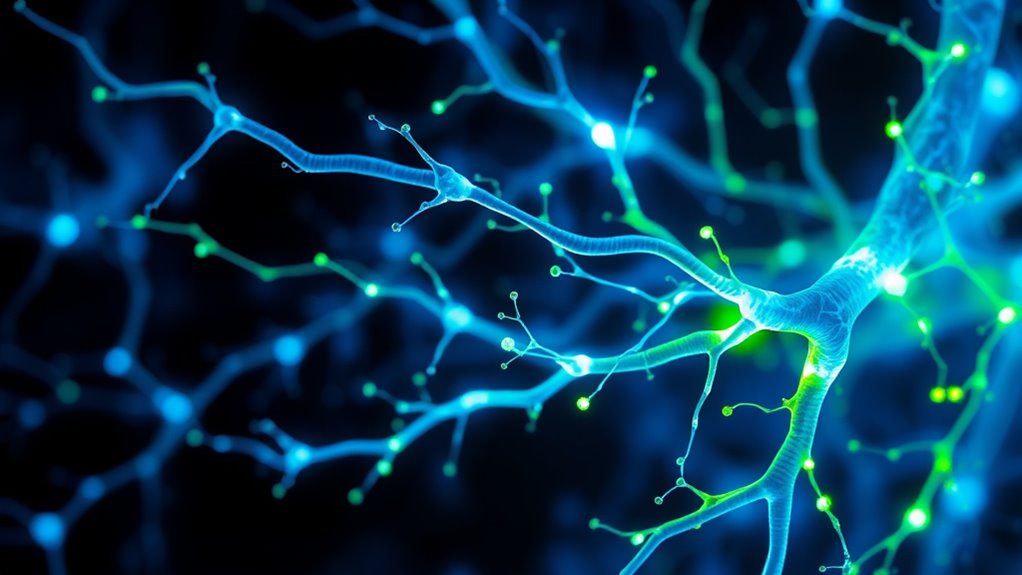Habit Building
Habit Stacking Recipes for Morning Energy
Create habit stacking recipes for morning energy that effortlessly boost your day—discover simple pairings that make waking up energized easier than ever.

To create habit stacking recipes for morning energy, link small actions to your existing routines. For example, after brushing your teeth, do quick stretches or drink a glass of water. Prep your breakfast right after your nighttime routine or open blinds as soon as you wake up. These simple pairings make developing energizing habits easier and more automatic over time. Keep exploring, and you’ll discover even more ways to energize your mornings effortlessly.
Key Takeaways
- Link a glass of water to your morning teeth brushing to hydrate and boost alertness instantly.
- Combine a quick stretching routine with opening blinds to energize your body as you wake up.
- Prepare a healthy breakfast or smoothie the night before, stacking it after your evening wind-down.
- Attach a gratitude or affirmation practice to your morning routine to start with positive energy.
- Incorporate light movement, like jumping jacks or yoga, immediately after waking to increase circulation and vitality.

Habit stacking recipes are a simple yet powerful way to build new routines by attaching them to existing habits. When you combine small, manageable actions with your current daily activities, you make it easier to create lasting change. If you want more morning energy, this approach can help you develop effective habits that stick. One way to start is by integrating meal prep ideas into your routine. For example, after you finish your nighttime routine, you can prepare your breakfast or pack your lunch for the next day. This not only saves you time in the morning but also guarantees you’re fueling your body properly, giving you the energy you need to start your day. By linking meal prep with your evening wind-down, you reinforce the habit without adding extra steps. Over time, this simple adjustment becomes second nature, and your mornings become less rushed and more energized.
Another key aspect to waking up refreshed is paying attention to sleep hygiene tips. Sleep is the foundation of morning energy, so you should prioritize habits that improve your sleep quality. You might stack a new habit like dimming the lights an hour before bed with your existing routine of brushing your teeth. This signals your body that it’s time to wind down, making it easier to fall asleep and wake up feeling more rested. Additionally, if you’re trying to establish a consistent wake-up time, you can link it to another morning activity, such as opening your blinds or doing light stretching. These small steps, when linked to habits you already do, can markedly boost your sleep hygiene and, consequently, your morning vitality. Incorporating knowledge about well-being tips can further optimize your routine for better energy and health.
You can also create a morning energy boost by stacking habits that involve movement or hydration. For instance, after you brush your teeth, you could do a quick set of stretches or drink a glass of water. It’s simple, quick, and integrates seamlessly into your existing routine. Over time, these small adjustments compound, helping you feel more alert and ready to tackle the day. The key is to choose habits that reinforce each other and are easy to perform consistently. Whether it’s meal prep ideas that keep your mornings organized or sleep hygiene tips that improve your rest, habit stacking makes it easier to develop routines that energize you each morning. With intentionality and consistency, these small changes can lead to big improvements in how you start your day.
Frequently Asked Questions
Can Habit Stacking Improve Overall Daily Productivity?
Habit stacking can definitely boost your overall daily productivity by reinforcing habit formation and improving energy management. When you link new habits to existing routines, you create seamless shifts that make behaviors stick. This streamlined approach reduces decision fatigue and helps you stay focused throughout the day. As a result, you’ll find it easier to build positive habits, maintain high energy levels, and accomplish more with less effort, leading to greater productivity.
How Long Does It Take to See Results From Habit Stacking?
Think of habit stacking as planting a seed; it takes a little time to see it bloom. Usually, you’ll notice small changes within a few weeks, but true results often appear after about 30 to 60 days. Staying consistent with your habit helps keep motivation alive and guarantees steady progress. Remember, patience and persistence are your best friends in this journey toward better routines and increased energy.
What if I Miss a Morning Habit—Should I Restart?
If you miss a morning habit, don’t stress. Missing opportunities to stick to your routine is normal, and you don’t need to restart everything. Instead, focus on habit flexibility—adjust your schedule or combine missed habits later in the day. Consistency matters, but setbacks happen. Keep moving forward, learn from missed opportunities, and remember that small adjustments help you stay on track without feeling overwhelmed.
Are Habit Stacking Recipes Suitable for All Age Groups?
You might wonder if habit stacking recipes work for all age groups. The answer is yes, but with some age appropriateness and customization tips. Younger kids may need simpler, short routines, while adults can handle more complex ones. Customize your stacking to suit your energy levels and preferences. Always consider safety and practicality, adjusting the recipes to fit your age and lifestyle for better success and consistency.
How Do I Customize Habit Stacks for Different Goals?
Imagine tailoring a suit versus buying one off the rack. Customization makes all the difference. To customize habit stacks for different goals, use personalization strategies that align routines with your unique needs. Break down goal-specific routines into manageable steps, then anchor new habits to existing ones. This way, you create a seamless, effective system that adapts to your evolving ambitions, ensuring each habit stack works perfectly for your personal success.
Conclusion
Now that you’ve activated these habit stacking recipes, imagine waking up tomorrow feeling unstoppable. The secret to sustained morning energy is within your reach—just one simple change away. But here’s the twist: what if the real transformation begins when you least expect it? Stay committed, and watch how these small shifts create a ripple effect, propelling you into a day filled with clarity and vigor. Your energized mornings are just the beginning—are you ready to discover what’s next?
Habit Building
Implementation Intentions: The ‘If‑Then’ Strategy That Works
Fascinating and effective, implementation intentions use specific “if-then” plans to turn goals into habits—discover how they can transform your success.

Implementation intentions use clear “if-then” plans to help you turn your goals into habits. By specifying exactly when and where you’ll act, you create mental cues that trigger automatic behaviors, reducing decision fatigue and increasing consistency. This strategy helps you anticipate obstacles and plan responses, making habits easier to stick to long-term. If you want to learn how to craft effective plans that boost your success, there’s more to discover below.
Key Takeaways
- Implementation intentions use clear “if-then” statements to link specific cues with desired behaviors, facilitating automatic action.
- They specify exactly when and where to perform tasks, reducing ambiguity and increasing the likelihood of follow-through.
- Planning responses to potential obstacles helps maintain consistency and resilience in pursuing goals.
- This strategy transforms vague intentions into concrete routines, fostering habit formation and long-term success.
- Implementation intentions minimize reliance on motivation by creating mental cues that trigger automatic behaviors.

Implementation intentions are a powerful tool for turning goals into action. They help bridge the gap between your intentions and your actual behavior, making it easier to develop new habits and achieve what you set out to do. When you create an implementation intention, you’re essentially planning out specific responses to certain situations, which can markedly improve your ability to stick to your goals. This technique transforms vague resolutions into concrete actions, increasing the likelihood that you’ll follow through even when motivation wanes. By linking a particular circumstance with a planned behavior, you set yourself up for success in habit formation and goal achievement alike.
Implementation intentions turn goals into actions, bridging the gap between intentions and behavior for lasting habits.
When you use the “if-then” format—like “If I finish work, then I’ll go for a walk”—you create clear mental cues that trigger your desired behavior. This approach minimizes the need for ongoing decision-making, which often leads to procrastination or abandoning your goals. Instead, your brain automatically associates the cue with the action, making it more likely you’ll act in line with your intentions. Over time, these repeated responses can solidify into habits, turning deliberate efforts into automatic routines. This makes long-term goal achievement more sustainable because you’re not relying solely on willpower or motivation, both of which can fluctuate.
The beauty of implementation intentions lies in their ability to make your goals more approachable by reducing ambiguity about what you need to do. When you specify exactly when and where you’ll perform a task, you eliminate the mental clutter that often sabotages progress. For example, instead of vaguely intending to exercise more, you plan, “When I wake up at 7 am, I will do a 10-minute stretch.” This precise plan increases your chances of acting because it creates a clear mental association that your brain recognizes as a cue to begin the behavior. As a result, your actions become more consistent, reinforcing positive habits that support your larger objectives.
Furthermore, these intentions help you anticipate potential obstacles and plan responses in advance, boosting your resilience. If you know that mornings are busy, you might set an “if-then” plan like, “If I don’t have time in the morning, then I’ll do a quick workout during lunch.” By preparing for these scenarios, you reduce the chances of skipping your habits or goals altogether. Additionally, understanding the importance of projector specifications like contrast ratio and color accuracy can help you choose the right equipment to support your visual goals. Over time, these small, planned responses become ingrained, making goal achievement feel less like an uphill battle and more like a natural part of your routine. Ultimately, implementation intentions empower you to take control of your behavior, making habit formation easier and your long-term goals more attainable.
Frequently Asked Questions
How Long Does It Take to See Results From Implementation Intentions?
When you ask how long it takes to see results from implementation intentions, timing expectations vary, but many notice progress within days to a few weeks. You should track your progress consistently to stay motivated and identify patterns. Keep in mind, results depend on your goals and consistency. By setting clear if-then plans, you can accelerate your progress and better evaluate how well your strategies work over time.
Can Implementation Intentions Be Used for Complex or Long-Term Goals?
You can use implementation intentions for complex or long-term goals, but their effectiveness depends on your goal complexity and long-term efficacy. By creating specific ‘if-then’ plans, you’re more likely to stay consistent and motivated over time. While they work well for simpler tasks, for more intricate or distant objectives, you might need to break down goals into smaller steps and regularly adjust your plans to maintain progress and motivation.
Are There Any Common Mistakes to Avoid When Creating ‘If-Then’ Plans?
Did you know that nearly 40% of goal plans fail due to poor planning? When creating ‘if-then’ plans, avoid common mistakes like vague triggers or unrealistic actions. To prevent planning pitfalls, be specific, realistic, and mentally rehearse your plans. Mistake avoidance is key—don’t overlook details or assume motivation will stay high. Clear, actionable steps help guarantee your ‘if-then’ strategy leads to success.
How Do Implementation Intentions Differ From Traditional Goal-Setting Techniques?
You’re curious about how implementation intentions differ from traditional goal-setting techniques. Unlike standard goals, which focus on the outcome, implementation intentions use specific ‘if-then’ plans to trigger habit formation and boost motivation. This strategy makes actions automatic, helping you overcome obstacles and stick to your goals more effectively. By linking cues to behaviors, you create stronger motivational techniques that turn intentions into lasting habits.
Can Implementation Intentions Be Effective for Behavior Change in Children?
Imagine planting a seed in a child’s garden; with the right care, it blooms. Implementation intentions can boost child motivation by creating clear ‘if-then’ plans, making behavior change feel like a natural growth. When parents involve themselves actively, they help children connect actions with outcomes, guiding them gently. This strategy turns abstract goals into tangible steps, making behavior change more effective and sustainable for kids.
Conclusion
By setting clear “if-then” plans, you turn your intentions into action. Imagine your goals as a garden: without a plan, weeds grow unchecked, but with a well-placed stake, your plants thrive. Research shows that implementation intentions can boost goal achievement by up to 50%. So, when you craft specific cues and responses, you’re planting the seeds for success—guiding your behavior like a gardener tending to a flourishing landscape.
Habit Building
From Cue to Craving: The Neuroscience of Habit Crystallization
Diving into the neuroscience of habits reveals how cues trigger cravings and neural pathways strengthen, but understanding how to rewire them offers hope for change.

When you encounter a cue, your brain triggers a dopamine response that creates a craving, reinforcing the behavior associated with that cue. Repeated actions strengthen neural pathways through plasticity, making habits more automatic over time. Dopamine signals reward, so your brain links the cue, craving, and reward cycle. As these neural connections grow stronger, habits crystallize. If you want to understand how this cycle can be changed, there’s more to uncover about the brain’s remarkable ability to rewire itself.
Key Takeaways
- Cues trigger neural pathways that activate dopamine release, initiating the craving process.
- Dopamine reinforces behaviors associated with cues, strengthening habit-related neural circuits.
- Repeated exposure to cues and rewards solidifies neural connections, leading to habit crystallization.
- Cravings emerge as dopamine signals anticipate the reward, making behaviors more automatic.
- Understanding cue-dopamine-craving cycles offers strategies for disrupting or establishing habits.

Have you ever wondered how certain habits become so ingrained they feel almost automatic? The answer lies deep within your brain’s wiring, specifically in the way your dopamine pathways and neural plasticity work together to shape your behaviors. When you perform an action repeatedly, your brain begins to strengthen the neural connections associated with that behavior. This process, known as neural plasticity, allows your brain to adapt and reorganize itself in response to your experiences. Over time, these strengthened pathways make the behavior easier to perform without conscious effort, eventually becoming a habit.
Dopamine pathways play a pivotal role in this process. When you engage in a behavior that leads to a rewarding outcome — like eating delicious food, checking social media, or smoking — your brain releases dopamine, a neurotransmitter associated with pleasure and motivation. This surge of dopamine acts as a kind of reward signal, reinforcing the behavior and encouraging you to repeat it. The more you perform the activity, the more your brain associates it with positive feelings, strengthening the neural connections involved. Over time, these connections become deeply embedded, making the response almost automatic. Additionally, neural plasticity enables the brain to rewire itself, facilitating both the formation and the alteration of habits over time.
Understanding this process is key to both building good habits and breaking bad ones. When you want to establish a new routine, you need to repeatedly activate the relevant neural pathways, encouraging neural plasticity to support the change. Conversely, breaking a habit involves disrupting the dopamine reward cycle and creating new pathways that override the old ones. Recognizing how dopamine pathways reinforce habits through reward and how neural plasticity allows these patterns to become deeply embedded gives you insight into how habits form and, importantly, how they can be altered. Your brain’s remarkable ability to rewire itself offers hope — change is always possible when you understand the underlying neuroscience.
Frequently Asked Questions
How Long Does It Typically Take to Form a New Habit?
You can typically form a new habit in about 21 to 66 days, though it varies based on your consistency and the habit loop involved. Your brain’s plasticity allows it to rewire itself as you repeat behaviors, strengthening neural pathways. The more you stick to the routine, the faster your brain adapts, making the new habit more automatic over time. Stay consistent, and your habit will crystallize sooner.
Can Habits Be Completely Unlearned or Just Replaced?
Think of habits as old friends—you can’t just erase them, but you can change the story. While complete unlearning is tough, you can achieve habit suppression by replacing subconscious triggers with healthier responses. Like pruning a tree, you trim the old habits and cultivate new ones. This process rewires your brain, making the old habits fade, yet the potential for them to resurface always exists, urging you to stay mindful.
What Role Does Genetics Play in Habit Formation?
Genetics influence how easily you form habits through genetic predispositions that affect your brain chemistry and behavior patterns. Your gene-environment interactions also play a role, meaning your environment can amplify or mitigate genetic tendencies. So, while some habits may be more ingrained due to your genetics, your surroundings and experiences interact with these predispositions, shaping how habits develop and how resistant they are to change.
How Do Environmental Changes Impact Existing Habits?
Environmental changes can profoundly impact your existing habits by altering environmental cues and contextual triggers. When your surroundings change, the familiar cues that prompt your habits may fade or shift, making it harder to follow through. Conversely, new cues might trigger different behaviors. By recognizing how environmental cues influence you, you can modify your environment to support or disrupt specific habits, helping you gain better control over your behaviors.
Are Certain Habits More Resistant to Change Than Others?
Did you know that about 45% of daily behaviors are habits? Some habits are more resistant to change due to strong resistance mechanisms and high habit persistence. You might find breaking certain routines difficult because your brain has wired these behaviors deeply, making them stick longer. These deeply ingrained habits resist change, requiring more effort and targeted strategies to modify than newer or less established ones.
Conclusion
As you understand the neuroscience behind habit crystallization, you’ll see how small cues can shape big behaviors. Did you know that about 40% of our daily actions are habits, performed almost automatically? Recognizing this, you can start to reshape your routines consciously. By understanding the brain’s role, you gain the power to break unwanted habits or forge new ones more effectively. Take control, and turn your cravings into positive, lasting change.
Habit Building
Why Keystone Habits Matter and How to Find Yours
Diving into keystone habits reveals how small changes can spark transformative growth; discover yours to unlock your full potential.

Keystone habits matter because they create a ripple effect that transforms various aspects of your life, making other positive behaviors easier to adopt. To find yours, focus on routines that energize or motivate you naturally, like waking early or practicing gratitude. These habits can reshape your mindset and environment, setting off a chain reaction of growth. Keep exploring, and you’ll discover how to harness these powerful routines to unleash your full potential.
Key Takeaways
- Keystone habits create a ripple effect, positively influencing multiple areas of your life and making overall change easier.
- They have a disproportionate impact, often leading to improvements in related habits like health, productivity, and mindset.
- Identifying your keystone habit involves focusing on routines that naturally energize or motivate you and affect other behaviors.
- Practicing stillness and self-awareness helps recognize which habits align with your goals and energize your daily routine.
- Consistently integrating a keystone habit builds momentum, embeds positive changes, and fosters long-term behavioral transformation.

Have you ever wondered why some small changes in your daily routine lead to widespread improvements? It’s because of the power of keystone habits—small behaviors that trigger a ripple effect, positively influencing other areas of your life. These habits play a pivotal role in habit formation, acting as catalysts that make behavioral change easier and more sustainable. When you focus on establishing a keystone habit, you’re not just altering one part of your routine; you’re setting off a chain reaction that can transform your entire approach to daily living.
Keystone habits are unique because they have a disproportionate impact compared to other habits. For instance, adopting a regular exercise routine often leads to better eating habits, improved sleep, and increased productivity. The reason is that these habits serve as a foundation for behavioral change, helping you build momentum and confidence. As you reinforce these core behaviors, other positive changes tend to follow naturally, making it easier to stay committed over the long term. This interconnectedness highlights why keystone habits are so powerful—they don’t just change isolated behaviors but reshape your overall mindset and environment.
Keystone habits create a ripple effect, transforming your mindset and environment for lasting positive change.
Finding your keystone habit involves paying close attention to what naturally energizes or motivates you. Think about routines that, once integrated, make other tasks feel easier or more manageable. Maybe waking up early gives you quiet time to plan your day, leading to increased focus and productivity. Or perhaps practicing gratitude daily helps you foster a more positive outlook, which influences your interactions and decision-making. The key is to identify behaviors that, when consistently practiced, create a ripple effect, improving multiple aspects of your life without requiring a complete overhaul. Recognizing these habits requires self-awareness and a willingness to experiment until you discover what naturally aligns with your goals.
Additionally, understanding the benefits of practicing stillness can help you develop greater self-awareness and emotional regulation, which support the formation of keystone habits. Once you identify your keystone habit, the next step is to focus on habit formation—making that behavior a consistent part of your routine. Start small, set clear intentions, and track your progress. The goal isn’t perfection but consistency. As you reinforce this core behavior, you’ll notice behavioral change occurring more effortlessly, because these habits become embedded in your daily rhythm. Over time, they influence your environment, mindset, and other habits, creating a cycle of continual improvement. Ultimately, understanding why certain habits matter and how to find yours empowers you to harness their full potential for lasting, positive change.
Frequently Asked Questions
Can Keystone Habits Change Over Time?
Keystone habits can definitely change over time as your life evolves. You might develop new routines or phase out old ones, leading to habit evolution. While consistency is important, it’s natural for your habits to shift with changing goals and circumstances. By staying mindful, you can intentionally adapt your habits, ensuring they continue to support your growth and keep you motivated.
How Do I Identify My Personal Keystone Habits?
To identify your personal keystone habits, pay attention to your habit triggers and daily routines. Notice which small changes in your routines cause bigger shifts in other areas of your life. Observe patterns when you feel most motivated or productive, and identify the habits that seem to set the tone for your day. These are likely your keystone habits, guiding your overall behavior and success.
Are Keystone Habits Effective for Mental Health Improvements?
Keystone habits can be highly effective for mental health improvements. By establishing routines like mindfulness practice and gratitude journaling, you create positive shifts in your mindset. These habits promote better emotional regulation, reduce stress, and foster resilience. When you consistently practice mindfulness and gratitude, you build a foundation for lasting mental well-being, making it easier to handle life’s challenges and enhance your overall mental health.
Can Keystone Habits Impact My Relationships?
Yes, keystone habits can profoundly impact your relationships by improving your relationship dynamics and communication patterns. When you develop habits like active listening or regular quality time, you foster trust and understanding. These small changes ripple through your interactions, making conversations more meaningful and reducing conflicts. By focusing on key habits, you create a positive cycle that strengthens your connections and enhances overall relationship satisfaction.
What Are Common Mistakes When Establishing Keystone Habits?
Did you know that 40% of daily actions are habits? When establishing keystone habits, avoid common mistakes like setting unrealistic goals or relying solely on motivation strategies. You might lose momentum if you don’t establish a clear plan or fail to track progress. Focus on habit formation techniques that build consistency, and remember, patience is key. Small, sustainable changes will help you develop lasting keystone habits.
Conclusion
By embracing keystone habits, you open the door to transformative change—like planting a single seed that grows into a flourishing garden. When you identify and nurture these habits, every aspect of your life begins to shift effortlessly. Remember, it’s not just about small steps; it’s about setting off a chain reaction that shapes your future. So, take that first step today—you hold the power to turn habits into your greatest allies.
-

 Wish Notes1 year ago
Wish Notes1 year agoBest Caption to Wish Myself a Happy Birthday That Everyone Will Like!
-

 Wish Notes1 year ago
Wish Notes1 year agoThe Best Birthday Wishes to Make Your Uncle's Day Bright!
-

 Wish Notes1 year ago
Wish Notes1 year agoThe Sweetest Happy Birthday Wishes for Your Wife!
-

 Wish Notes1 year ago
Wish Notes1 year agoThe Best Happy Birthday Wish for Your Brother That Will Make Him Smile!
-

 Wish Notes1 year ago
Wish Notes1 year agoHeartwarming Birthday Messages for Mom in Spanish
-

 Wish Notes1 year ago
Wish Notes1 year agoThe Best Happy Birthday Wishes for Your Husband That Will Make His Day!
-

 Wish Notes1 year ago
Wish Notes1 year agoThe Ultimate Birthday Wishes to Celebrate Yourself!
-

 Wish Notes1 year ago
Wish Notes1 year agoThe Most Heartfelt Good Night Wishes Ever!





















